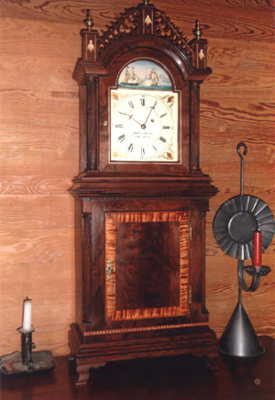
Here's My Woodworking!
by Jim Chandler
Union Mills, NC
Click on any picture to see a larger version.
I have been an avid woodworker for well over 36 years now. There are many things that I have learned during my time in the shop. Never be afraid to make the next cut if you feel that you can still achieve better results, and also recognize that sometimes it's not the end of the world when you have to start again. I find that wood is a lot like people: there will be pieces that are easy to carve and shape and then there will be some that are more difficult to work with. When we have the ability to recognize these differences and can compensate for them accordingly, it gives one a much greater feeling of accomplishment when the project is completed.
I have always been drawn in by antiques that were made prior to the industrial revolution. These are pieces that were made entirely with the use of hand tools. I find it fascinating to be able to admire the work of a fellow cabinet maker who has passed away, yet his work carries on, giving us all inspiration and a chance to connect with the past. For many years I have wanted to make a Massachusetts Shelf Clock, but as many of you well know the projects that we want for ourselves take a lower priority and can often be forgotten with time. I started this project well over two years ago, keeping the bits and pieces off to the side and working on them when time would allow.
The Massachusetts Shelf Clock was introduced sometime between 1760 and 1770. The standard tall case clock was much too expensive for the majority of Americans who were still trying to settle into the newly developing colonies. The Massachusetts Shelf Clock was basically a scaled down version of a tall case clock, using about half of the wood and brass that would have been required if a full sized tall case clock had been made. The clock quickly gained popularity and different versions were made from the early 1760s through 1820.
The clock that I made stands at just 40" tall and the primary wood is walnut with pecan as a secondary wood. The lower door has a cross banding of tiger maple framed in cherry. The center panel for the door is highly figured walnut.
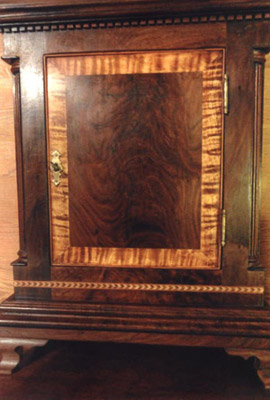
I found that the fluted columns and quarter columns were rather interesting to do. Once the wood had been turned on the lathe to the proper diameter I took a straight-edged metal ruler and scored a line the full length of the column. I then used a Stanley beading tool and carefully followed the groove of the score line. Once the first bead or flute had been established, then successive flutes were easy to create. For the quarter columns, four pieces of wood were glued up with a layer of brown paper between each piece. Once the wood had been turned to the proper diameter, I used a chisel to separate the wood at the glue joints, giving me four quarter columns. Again a line was scored and the hand beading tool was used to create the flutes.
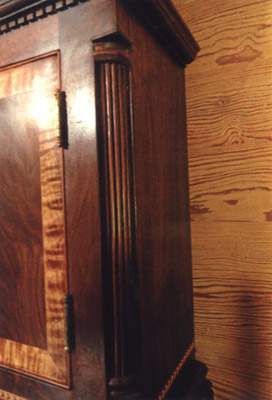
For the moldings I used a combination of fillister plane, rabbet plane, hollows and rounds. The only section of moldings that I wasn't able to use the hand planes on was the arched top of the hood. For this portion I had to use all hand chisels due to the curvature of the arch.
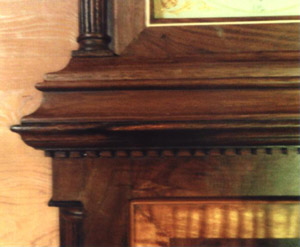
The bell flowers were inlaid with holly that had been sand shaded. This is a process of heating a batch of sand and then exposing the edge of the holly until it is just slightly scorched. When doing the inlay, the holly must be perfectly level with the material receiving the inlay. Unlike other inlays, you are unable to remove any of the material that stands proud of the base material. Sanding or using a scraper would remove the scorched material, thus eliminating the desired effect of the sand shading.
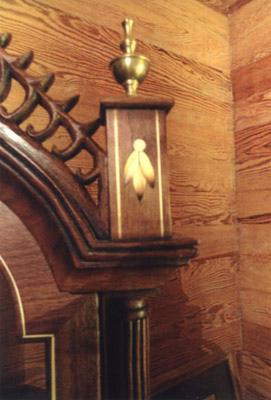
The fretwork on top of the clock was first cut out with a coping saw and then all carved by hand. The stringing at the base of the clock was also all made by hand using maple and mahogany. I used a herringbone pattern that I felt was appropriate.
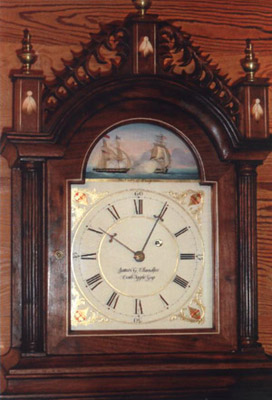
The dial was hand painted by an artist from Georgia who specializes in clock dials. While I am usually not all that struck with naval battle scenes on a clock face, this one seemed exceptional. It depicts the battle between the Hornet and the Penguin. The War of 1812 had come to an end, yet without the modern telecommunication capabilities that we currently have, the ships that were out to sea had no way of knowing. The Hornet and the Penguin happened upon one another several months after the end of the war, but without knowledge of the war's end the two ships engaged in battle. Even though it was outgunned, the USS Hornet was victorious over the Penguin.
The clock movement itself was all handmade by David Lindow. He is touted as the last person in the United States that still makes clock movements by hand.
This project has given me such a great feeling of accomplishment that I have already started plans for another clock. Perhaps this time it won't take me two years to finish it.
Jim was also featured in our
April 2010 Show Us Your Shop
column. You can email Jim at
Jim.Chandler@iwghpc.com
.
Would you like to see your woodworking in this column? We invite you to
SEND US PHOTOS
of your favorite woodworking projects along with captions and a brief history of your woodworking.
(Email photos at 800x600 resolution.) Receive a $50 store gift card if we show your stuff in a future issue.
Return to
Wood News
front page


